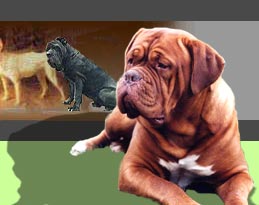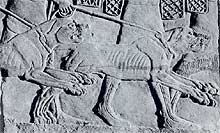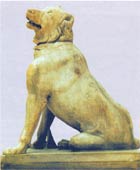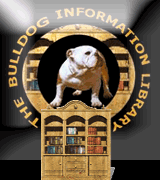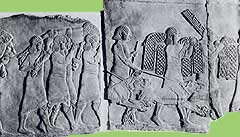.
.
.
To conclude we may say that Molossians were of two sizes, the larger of which was used as a flock and home guardian. One had a far wider jaw or muzzle than the other. It was shorter, often undershot. The second had the longer, narrower muzzle that is associated with the Molossians shown in Greek sculpture.
For the flock guardian, white was the preferred color. White dogs blended with the color of the animals at night. Black dogs did not and could scare the animals they had to guard. They were used as home guardians.
However, there are also contradictory reports. The description of the Molossian made by Nemesianus in the 3rd century A.D. sounds more like the big Greek Saluki then any kind of mastiff. Other cynologists as well state categorically that 'the Molussus was not in reality a Mastiff... the true Molossian was an erect-eared, slate coulored or fawn, swift-footed wolfish-looking dog.'
The best explanation of these contradictory descriptions is probably that the Molossi had more than one type of dog.
The Greeks were the first to write manuals about dogs; a practice which was continued by the Romans.
Aristotle was the first to discuss the anatomy and physiology of the dog. In 350 B.C., he listed the 'most useful' known breeds, among them the Molossian.
However, the identification of the breeds in Greek art is made more difficult by the tendency of many artists to stylise or idealise their subjects, but several breed types can be recognised.
The two main types most commonly mentioned are the Laconian and the Molossian dog, the Laconian being the sleek smooth-haired hound used for hunting deer and hares and the Molossian being the stockier more rough-haired hound used for boar hunting.
Varro, writing around 37 B.C. gives a 'breed standard' for this type of dog: "They should be comely in face, of good size, with eyes either darkish or yellowish, symmetrical nostrils, lips blackish or reddish, the upper lip neither raised too high nor drooping low, stubby jaw with two fangs projecting somewhat from it on the right and left, the upper straight rather than curved, their sharp teeth covered by lip, large head, large and drooping ears, thick shoulders and neck, the thighs and shanks long, legs straight and bowed rather in than out, large wide paws which spread as he walks (...) the backbone neither projecting nor swayed, tail thick; with a deep bark, wide gape, preferably white in colour, so that they may the more readily be distinguished in the dark; and of leonine appearance."
Flock guardians did not herd flock but simply guarded them. They were huge, savage dogs, large enough to keep away wolves and leopards. They had to guard against strangers, as well as against wandering stray dogs, wolves and big game, and men bent upon stealing parts of the flocks. They could fiercely fight intruders, be they human or animal. It is not clear whether the Greeks had driving and herding dogs in addition to their guard dogs. These dog did not necessarily develop in Tibet, but rather in Central Asia.


